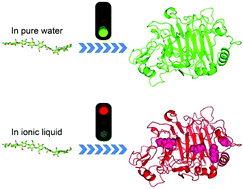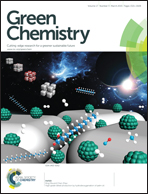Ionic liquid induced inactivation of cellobiohydrolase I from Trichoderma reesei
Abstract
Ionic liquids (ILs) exhibit unique capabilities in dissolving cellulose, the most abundant bioorganic material on earth, thus providing another promising source for biofuels. In this study, structural stability and interactions of cellulase cellobiohydrolase I (CBHI) in ionic liquid (1-butyl-3-methylimidazolium chloride, [Bmim]Cl) solution were investigated through computer simulations. At a moderately low concentration (0.8 M) of [Bmim]Cl, the cellulase CBHI showed both thermostability and IL-resistance at room temperature as well as a higher temperature of 350 K. However, several [Bmim]+ cations were found to be able to intrude into the interior of cellulase, especially near the cellulose binding tunnel and the active site for hydrolysis. These [Bmim]+ can compete with the binding of the cellulose substrate and directly block the hydrolysis pathway, which are responsible for the cellulase inactivation found in experiments. Three important residues, H228, W376 and R251, are identified to potentially improve the IL-resistance on cellulase. Motivated by the experiment, in silico mutagenesis studies of H228R have been conducted to examine the IL binding at the active site, in which the binding affinity of [Bmim]+ in the mutant is significantly reduced, by 20%, as compared to the wild type due to the repulsive interactions from the new arginine residue. Our findings have uncovered the inactivation mechanism of cellulase in the IL environment and pointed out the potential solutions for industrial-use cellulase enzymes in IL through protein engineering.


 Please wait while we load your content...
Please wait while we load your content...